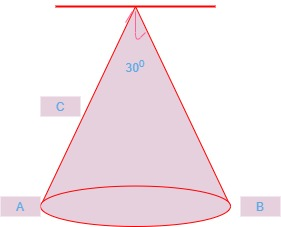Question
Question: A \( 0\cdot 2\text{ kg} \) ball is suspended by a thread of length \( 1\text{ }m \) . It is pulled a...
A 0⋅2 kg ball is suspended by a thread of length 1 m . It is pulled a side until the thread makes an angle of 30∘ with a vertical. How much work is done against gravity? The ball is now released. Find the velocity at the lowest point. Ignore air resistance and take g=10 ms−2 .
Solution
When a ball is suspended by a thread, it acts like a pendulum. When the particle is at a mean position, its potential energy is zero, kinetic energy is maximum , but kinetic energy is zero. Work done by a ball is due to work done by gravity which is given by potential energy.
Use the work energy theorem, according to which change in kinetic energy is equal to work done and work done is equal to potential energy. It means change in potential energy is equal to change in kinetic energy.
And we can calculate velocity at the lowest point.
Formula used: Work done due to gravity =mg h
By work energy theorem △K.E= work done
(K.E)A−(K.E)B=−(P.E)A+(P.E)B(K.E)A=(P.E)B
Here A is a mean position.
B is an extreme position.
21mv2=mg hv2=2hmg hv=m2mg h .
Complete step by step solution
We have a blue suspended by a thread. A is the mean position and B is the extreme position.

Mass of ball is given by m=0⋅2 kg this is the length of thread.
∠AOB=θ = 30∘
Since BC is perpendicular to DA
Take a perpendicular △BOX, Cosθ=OBOC OC=OBcosθ OC=1×cosθ
Here, thread is at
30∘ anglecosθ=cos 30∘=23
Oc=1×23=21⋅73205OC=0⋅866OA=1 cm
Height through which ball is raised,
h=AC=AO−OCh=1−0⋅866=0⋅134 m
Work done due to gravity is given by
=mg h=0⋅2×10×0⋅134 m work done =0⋅268 J
By work energy theorem,
According to this, the work done by all forces acting on a particle equals change in the K.E of the particle.
!!]!! △K.E=Work done△K.E=−△P.E [because , in this case work done due to gravity (K.E)A−(K.E)B=−(P.E)A+(P.E)B(K.E)B=0, at extreme position kinetic energy is zero(P.E)A=0, at mean position potential energy is zero.
!!]!! (K.C)A=(P.E)B21mv2=mg h21mv2=0⋅268 Jv2=m2×0⋅268 =0⋅22×0⋅268 =10×0⋅268v2=268v=1⋅63 ms−1[Ans
Hence work done by ball is 0⋅268 J
And velocity at lowest point is 1⋅63 ms−1
Note
Work energy theorem: The work done by the net force on a particle is equal to the change in the particle's kinetic energy.
W=△K.E=21mvf2−21mv2
The work energy theorem can be derived from Newton's second law: kinetic energy is directly proportional to the mass of the object and to the square of its velocity.
Potential energy is energy an object has because of its position relative to the same other object.
The formula of potential energy depends on the force acting on two objects.
